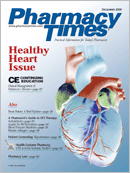Publication
Article
Pharmacy Times
Hypertension Counseling Requires a Multifactorial Approach
Author(s):
The World Health Organization has estimated that hypertension is the third leading cause of death in the world. The prevalence of hypertension in the United States has increased by 30% in the past 10 years, affecting 1 in 4 Americans, and one third of those affected are unaware of their condition.1,2
Overwhelming evidence supports the use of antihypertensive agents in lowering blood pressure. Evidence also shows the direct relationship of these agents with reduction of strokes, heart attacks, and heart failure. Yet, only 59% of Americans currently take their antihypertensive medications.3
Many studies have documented the importance of pharmacist interventions in improving health outcomes, adherence rates, and overall well-being.4 Key initial approaches for pharmacists are to identify patients at risk for developing hypertension, to focus on patients with an existing diagnosis, and to encourage adherence to therapies.
Treatment
Treatment of hypertension entails lifestyle modification and/or antihypertensive medications. Lifestyle modifications are recommended for all persons with prehypertension so as to prevent progression to hypertension, as well as for patients concomitantly taking medications.
The main modifiable causes of high blood pressure are diet, salt intake, lack of exercise, obesity, excessive alcohol intake, and smoking.1 One's diet should be low in saturated fat, cholesterol, and total fat and rich in potassium, magnesium, calcium, protein, and fiber. Also, emphasis should be placed on the consumption of fruits, vegetables, low-fat dairy products, whole grains, fish, poultry, and nuts. Sodium reduction is recommended at >2.4 g/day. Other recommended modifiable factors include increasing aerobic exercise to 30 to 45 minutes/day, limiting alcohol intake to 1 oz/day, and promoting smoking cessation.5
The following medications have been shown to reduce blood pressure and cardiovascular complications to a similar extent in patients with hypertension: thiazide diuretics, beta-blockers, angiotensin-converting enzyme inhibitors, angiotensin II receptor blockers, and calcium channel blockers (Table). These agents are considered first-line, and most patients will be initiated on one of these agents unless there are compelling indications to suggest an alternative.5 Initially, patients may be controlled with a single agent, but most patients will require 2 or more antihypertensive medications to achieve goal blood pressure.
Pharmacist's Role
Pharmacists have the opportunity to provide patient-oriented pharmaceutical care at each patient encounter (clinic visits, prescription refill, etc). All patients should be encouraged to take an active role in planning, implementing, and monitoring their treatment. It is important to stress that hypertension is a life-long and progressive disease, but a disease that can be controlled so as to reduce one's risk of cardiovascular complications in the future. Patients also need to understand that they are ultimately responsible for taking their medications.
When treating patients, it is important to set up a blood pressure goal (depending on their concomitant disease states) and a plan to reach that goal. Ideally, the goal should be <140/90 mm Hg, but patients with diabetes and kidney disease will have a lower target goal of <130/80 mm Hg. The key is to set reasonable time limits for patients to achieve these goals.
A major concern in antihypertensive therapy is the high proportion of patients whose blood pressure still is uncontrolled. Studies have indicated that roughly half of the patients who use drug therapy to treat hypertension do not adhere to their medication regimen or discontinue use within 1 year. Inadequate knowledge of the disease or treatment, denial of illness, lack of symptoms, lack of patient involvement in the care plan, unwanted side effects (Table), and cultural or socioeconomic factors all may increase a patient's nonadherence to therapy.6-9
- Identify poor adherence through missed appointments ("no shows," missed refills, etc)
- Emphasize the value of the regimen and the effect of adherence
- Listen to patients and elicit their feelings about their willingness to follow a regimen
- Enlist family support systems for encouragement
Provide simple, clear instructions, and simplify regimens8,9
Hypertension is a relatively asymptomatic disease, and medications are not without adverse side effects. When counseling patients, it is imperative to review expected and unexpected side effects of the drugs.7 When appropriate, it is good practice to routinely assess patient satisfaction with therapy, health perception, and physical functioning. Patients should be encouraged to talk with their health care provider before they decide to start or stop taking any medication or herbal products.
Monitoring/Follow-up
Patients who have been identified as prehypertensive should be followed annually, with lifestyle adjustment, encouragement, and blood pressure monitoring. Patients who have started medications for high blood pressure should return monthly for evaluation and adjustment of their doses until the blood pressure goal is reached. Once they are at goal blood pressure and stable, follow-up visits can be at 3-to 6- month intervals. More frequent monitoring is recommended for patients with comorbid conditions.
Pharmacists should monitor patients for inadequate doses, inappropriate combinations, side effects, drug interactions (eg, with nonsteroidal antiinflammatory drugs, decongestants, dietary supplements, and herbals), and adherence. They should ensure that patients get appropriate yearly care. They also should assess the need for lowdose aspirin when appropriate.
Blood Pressure Monitoring
Patients should be encouraged to invest in a home blood pressure monitoring machine. Home monitoring improves blood pressure control as well as adherence to drug therapy and reduces overall medical costs. Patients should be encouraged to consult with their pharmacist or physician prior to purchasing a monitor. Fully automated arm-cuff monitors are considerably more accurate than wrist or finger monitors.
Pharmacists should review with patients the instructions for using the monitors appropriately and for interpreting the results. They should encourage patients to keep a log of their readings and to bring it with them to office visits.10
Dr. Vadher is an assistant professor of clinical pharmacy at the University of the Sciences in Philadelphia, Pa.
For a list of references, send a stamped, self-addressed envelope to: References Department, Attn. A. Stahl, Pharmacy Times, 241 Forsgate Drive, Jamesburg, NJ 08831; or send an e-mail request to: astahl@ascendmedia.com.







